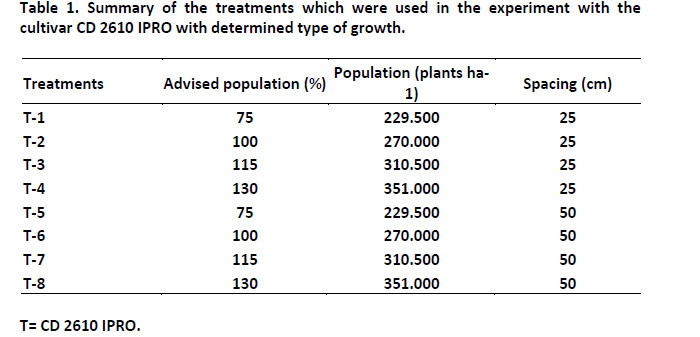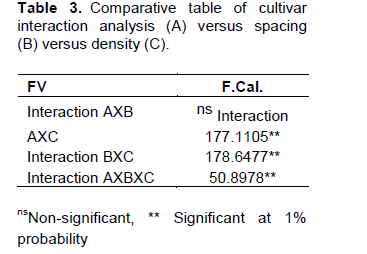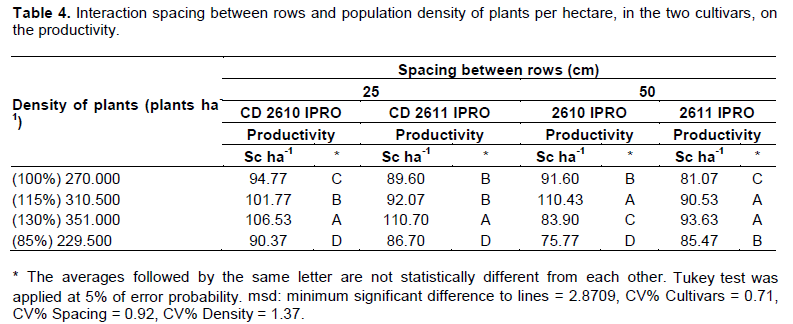ABSTRACT
Soybean has great importance in world economy. Their productivity is influenced by numerous factors like nutrition, pests, diseases, genetic factors, and weather and plant density to name a few, and the spatial distribution of plants per area a resource to increase productivity the aim of this study was to evaluate main items of productivity and soybean yield with different arrangements of plants with spacing (0.25 and 0.50 m), and population density of plants per unit area (351,000, 310,000, 270,000, 229,500 plants per hectare). The experiment was conducted in agricultural year 2013/2014, with cultivar CD 2610 IPRO® with determined type of growth and CD2611 IPRO® with indeterminate type of growth. The experiment design was conducted in a randomized block design with split-plot, containing three repetitions and for statistical analysis, we used Assistat program in sub-divided form. The two varieties tested showed significant results in 0.25 m space between plants with a density of 351,000 plants per hectare.
Key words: Arrangement, Glycine max, densities, growth.
Soybean (Glycine max) is a legume grown in almost all arable regions. Their large number of varieties adapted for macro and micro regions, leads crops to have diversity in climatic demands, allowing its exploitation in South and North America, Asia, Africa, Europe and Oceania. Its high nutritional value and its exploitation of various products from this legume have favored its exploitation around globe. Brazil is the second largest producer, exporter and soybean consumer, and annually planted area were 12 million hectares (Conab, 2016). The greatest combination with productive potential of crop depends on environmental conditions where plants will be install and how they will develop. Thus, changes related to plant population can reduce or increase productivity gain, because it depends into spacing and density between plants. The plant population is the factor that least affects productivity, since plants were distribute uniformly in the area (Endres, 1996; Luca and Hungria, 2014).The spacing between lines and density among plants can be manipulated in order to establish a more suitable arrangement to obtain higher productivity. According to Procópio et al. (2013), in arrangement, where row spacing is equal to plant spacing along lines, it observed increases in soybean yield. The best use of incident radiation can be main responsible factor for obtaining higher yields in smaller spacing (Reunião, 2012). Soybean plants can provide great flexibility in response to different spatial arrangements, and can adapt to large-scale environmental managements (Heiffig, 2002;). The same author obtained for smaller spacing a better and faster lock between lines, providing better control of weeds.
According to Parcianello et al. (2004), reduction in spacing also increases radiation interception, leaf area index and grain yield, being highest number of pods per m2, this parameter explains increase in grain yield. Ventimiglia et al. (1999), determines higher yield potential and actual yield, which justifies the increase in productivity. Plants distributed inappropriately prevent correct use of available resources such as light, water and nutrients. In soybean cultivation, high plant population at some points can cause development of higher plants, less branched, with less individual production, reduced stem diameter and therefore more prone to lodging. On other hand, blank spaces between plants and between lines can facilitate weeds development, not to mention the fact that they can lead to soybean plants establishment with reduced size.
According Pitelli (1985), factors that influence interference degree of a weed plant in crop may related to weed community (specific composition, density and distribution), culture (cultivar, spacing and density) and environment (management practices, soil and climate).The major advantages observed with reduced spacing, compared to commonly used (40 to 50 cm) are verified in delayed sowing using early cultivars , and fertility soils at suitable levels (Ventimiglia, 1996).The aim of this study was evaluate main components, and soybean yield productivity, with different plants arrangements of two varieties: one with a determined type of growth (CD 2610
IPRO®) and second with indeterminate growth type (CD 2611 IPRO ®) with spacing (50 and 25 cm) and density of plants per unit area (351.000, 310.500, 270.000, 229.500 plants per hectare).
The experiment was applied in experimental area of Coodetec (Agricultural Research Central Cooperative) company, Located in Cascavel city, in west Paraná (BR), Brazil, during October 2013 to March 2014, in an area with altitude of 781 m. The soil was classify as typical dystrophic, gentle relief, basalt substrate (Embrapa, 2006). The management of experiment was carried out in accordance with technical recommendations given to their cultivation. Sowing was applied on 26 October 2013. The cultivars used were CD 2610 IPRO® with determined habit of growth and CD 2611 IPRO® with indeterminate habit of growth. The seeds were treated with fungicide (Maxim®) and insecticide (Standak®), all measurements were in accordance with recommendation of manufacturers products. The fertilization was performed along with sowing, using the commercial formula 02-20-20NPK at a dose of 295 kg ha-1. We used experimental design of randomized blocks with split-plots and three repetitions, totaling 48 parcels. Each plot with dimensions of five meters long by two meters wide, with a total area of 10 m2 per plot.
For cultivar CD 2610 IPRO® with determined type of growth, used treatments were shown in Table 1. For cultivar CD 2611 IPRO® with indeterminate growth, used treatments were shown in Table 2. For treatments density accuracy, were sown with 5% more seeds per plot, and after seedlings emergence, they were thinned out, leaving only exact population for each treatment. For chemical control of pests and diseases, two systemic insecticide applications from group of pyrethroids (Betacyflutrina and Lambda-cyhalothrin) were apply. A preventive fungicide (Opera®) it was apply for bug’s control. Three more applications of systemic fungicide from chemical group Benzimidazole + triazole (Derosal® + Aproach Prima®) using a trailed sprayer with conical nozzles in the flow of 200 L ha-1 were applied. During cultivars cycle we assessed blooms days, being on average 42 days after emergence and material full cycle on average 115 days of maturation.


The harvest was held on 8 March, 2014 with a parcel harvester Wintersteiger (100% of the plot was harvested). Following were performed in the laboratory evaluations. The evaluations were: weighing of parcels were carried out, 1000 grain weight, moisture and productivity transformation of plots in sacks h-1. When the f test was significant, the collected data were analyzed in the Assistat Software on Turkey’s test program at 5% probability in sub-subdivided form of the harvested yields.
During experiment period (from planting to harvest), rainfall were 727 mm not well distributed causing stress to crop in grain formation stage. Interaction analysis between data, shown no significant interaction between the variety with determined kind of growth and the variety with indeterminate kind of growth versus spacing 0.25 and 0.50 cm (AxB). On the other hand, when comparing the interaction test of the two varieties versus density (AxC) there was significant difference, and when comparing the spacing versus density (BxC), there was significant difference and also when we compared all against all (AxBxC) there was a significant interaction according to Table 3. In the different spatial arrangements, it was possible to see the inherent characteristics of each plant with regard to the architecture and management of the culture. Analyzing the spacing of 25 cm between rows of determined kind of growth, there was a greater regularity among plants in the experiment. In this spacing the plants were better distributed and will compete less for space, water and nutrients, so that they can express their full potential. As negative aspect, there was the formation of a favorable environment for the development of pests and diseases by promoting greater protection to the sun and spraying.
According to Almeida et al. (2005) the lower spacing can cause major problems with diseases such as White Mold (Sclerotinia sclerotiorum). According to Embrapa (2000), the cultural weed control consists of management techniques that foster the development of soybeans over the weed and in this case was obtained by canopy closure reached quickly due to the reduced spatial arrangement. Spacings smaller than 40 cm between rows are even better for weed control in the crop. By and large, the spacing of 50 cm had the highest irregularity in the development of the architecture of plants, because the competition between them was greater. Another important aspect is that the tested cultivars are semi-early and have a smaller branch capacity, then the lines remained open throughout the cycle, favoring the development of weeds. The weeds damage the crop owing to the fact that they compete for sunlight, water and nutrients, hinder the harvesting operation and compromise the quality of grain, depending on the weed species and the infestation level (Embrapa, 2000). On the other hand, a positive aspect was the control of diseases and pests which became more efficient, probably because there was no formation of an ideal microclimate for the development of them. With the smallest gap was associated with the largest number of plants per plot, however, this also raises the level of productivity for the two varieties where statistically the two varieties in the same spacing and the same density (351,000 plants / ha-1) produce equally among each other, according to Table 4.


When compared both cultivars within each spacing, it was observed that for the conventional line spacing (0.50 cm), the cultivar CD 2610 IPRO® was the one which obtained the lowest result of agricultural productivity, while in the reduced spacing (0, 25 cm), the same cultivar CD 2610 IPRO® was the one which most produced in the experiment reaching 110.7 ha-1 bags (Table 4).The cultivars CD 2610 IPRO® and CD 2611 IPRO® do not respond when seeded with lower densities than recommended in the case (85%), also comparing with different spacing, as reflected in the soybean plant physiology, this is because their ability to adjust their production components to maintain the level of agricultural productivity of farming in different situations spacing between plants and between rows (Table 4). Comparing the behavior of the cultivar CD 2611 IPRO® in two densities with 310,500 and 351,000 plants per hectare, they are statistically equal among each other in spacing of 0.50 cm between rows (Table 4). Therefore, we can affirm that this cultivar can withstand higher plant population per unit area with reduced spacing without the occurrence of layering, thus having major agricultural productivity.
For the two varieties tested, there was significant results in the spacing of 0.25 cm with 351,000 plants density per ha-1, this spacing and this density provided less competition between plants, resulting in higher productivity. In low density with 85% rating (229,500 plants ha-1) showed lower results in productivity when compared to the others.
The authors have not declared any conflict of interests.
REFERENCES
|
Almeida AMR, Ferreira LP, Yorinori JT, Silva JFV, Henning AA, Godoy CV, Costamilan LM, Meyer MC (2005). Manual de fitopatologia: doenças da soja. Escola Superior de Agricultura "Luiz de Queiroz" (ESALQ), São Paulo - SP: Agron. Ceres 2:569-588.
|
|
|
|
Companhia Nacional de abastecimento (CONAB) (2016). Acompanhamento da safra brasileira de grãos. Disponível em:
View. Acesso em: 01 de fevereiro de 2016.
|
|
|
|
|
Embrapa (2000). Centro Nacional de Pesquisa de Soja (Londrina, PR). Recomendações técnicas para a cultura da soja no Paraná: safra 2000/2001. Londrina- PR 255 p.
|
|
|
|
|
Embrapa (2006). Centro Nacional de Pesquisa de Solos. Sistema brasileiro de classificação de solos. Rio de Janeiro - RJ: Embrapa Solos.
|
|
|
|
|
Endres VC (1996). Espaçamento, densidade e época de semeadura. In: Embrapa - Centro de Pesquisa Agropecuária do Oeste (Dourados, MS). Soja: recomendações técnicas para Mato Grosso do Sul e Mato Grosso. Dourados – MS pp. 82-85.
|
|
|
|
|
Heiffig SL (2002). Plasticidade da cultura da soja (Glycine max (L.) Merrill) em diferentes arranjos espaciais. Dissertação (Mestrado em Agronomia Fitotecnia) – Escola Superior de Agricultura "Luiz de Queiroz", Piracicaba (SP) 85 p.
|
|
|
|
|
Heiffig LS, Cämara GMS, Marques LA, Pedroso DB, Piedade SMS (2006). Fechamento e índice de área foliar da cultura da soja em diferentes arranjos espaciais. Bragantia 65(2):285-295.
Crossref
|
|
|
|
|
Johnson RR, Green DE, Jordan CW (1982). What is the best soybean row width? Crops and Soils Magazine, Madison 43(4):10-13.
|
|
|
|
|
Luca MJ, Hungria M (2014) Plant densities and modulation of symbiotic nitrogen fixation in soybean. Sci. Agric. 71(3):181-187.
Crossref
|
|
|
|
|
Parcianello G, Costa AJ, Pires FLJ, Rambo L, Saggin K (2004). Tolerância da soja ao desfolhamento afetada pela redução do espaçamento entre linhas. Ciênc. Rural Santa Maria- RS 34(2):357-364.
|
|
|
|
|
Pitelli RA (1985). Interferência de plantas daninhas em culturas agrícolas. Inf. Agropecu. 11(129):16-27.
|
|
|
|
|
Procópio SO, Balbinot Junior AA, Debiasi H, Franchini JC, Panison F (2013). Plantio cruzado na cultura da soja utilizando uma cultivar de hábito de crescimento indeterminado. Rev. de Ciênc. Agrár. 56(4):19-325.
Crossref
|
|
|
|
|
Ventimiglia LA (1996). Morfogenia e fisiogenia da soja afetada pelo espaçamento entre fileiras e níveis de fósforo no solo. Porto Alegre: UFRGS. Dissertação (Mestrado em Agronomia) -Fitotecnia, Faculdade de Agronomia da UFRGS 118 p.
|
|
|
|
|
Ventimiglia LA, Costa JA, Thomas AL, Pires, JLF (1999). Potencial de rendimento da soja em razão da disponibilidade de fósforo no solo e dos espaçamentos. Pesqui. Agropecu. Bras. Bras. DF. 34(2):195-199.
Crossref
|
|